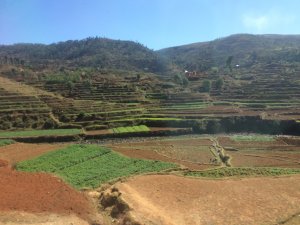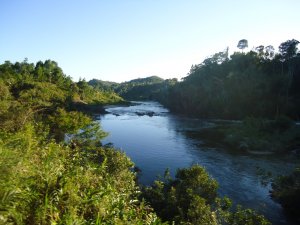I arrived in Antananarivo, Madagascar a week ago, jetlagged after more than a full day of travel, but attempting to stay coherent as I navigated my way through customs and baggage claim. A bright orange vest and a sign with my name on it told me I had found the MBP driver amongst a crowd waiting outside the airport doors. Signs for National Geographic and World Wildlife Fund caught my eye as well. After introducing himself as Jean Pierre, he led me back into the airport to exchange money and purchase a SIM card, and back out again to find a black Volkswagen bug with the MBP logo on the side. The drive into Antananarivo gave me my first glimpses of the country, though at 1 in the morning, there were more stray dogs than people wandering the town. Though Jean Pierre was very kind, attempts at conversation were short, as I don’t know any French and only know basic phrases and words in Malagasy. After we arrived at the hotel, Jean Pierre helped me check in, and I bid him farewell. Although roosters were already crowing at 3am when I had finally settled in, a large mattress about a foot and a half off the floor welcomed me into a deep sleep.
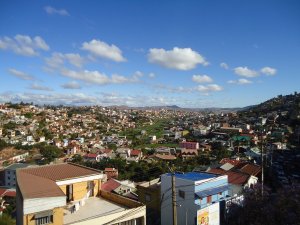 The next couple of days were spent sleeping, learning new Malagasy words, getting to know the other three volunteers, and eating delicious food prepared in the hotel’s restaurant. Rice dominated most of the vegetarian meals, but vegetables added savory flavors. The most expensive meal I had cost 7,000 Ariary, the equivalent of about $2.25. Watching the town’s activity from my balcony or the roof helped keep us entertained. The third and last full day in Antananarivo began with a morning shopping trip to purchase cheap phones for a couple of the volunteers and electrical adapters for all of us. Traffic in the city was unlike anything I had experienced, with constant honking and weaving around the foot traffic, bicycles, and mopeds on either side of the road.
The next couple of days were spent sleeping, learning new Malagasy words, getting to know the other three volunteers, and eating delicious food prepared in the hotel’s restaurant. Rice dominated most of the vegetarian meals, but vegetables added savory flavors. The most expensive meal I had cost 7,000 Ariary, the equivalent of about $2.25. Watching the town’s activity from my balcony or the roof helped keep us entertained. The third and last full day in Antananarivo began with a morning shopping trip to purchase cheap phones for a couple of the volunteers and electrical adapters for all of us. Traffic in the city was unlike anything I had experienced, with constant honking and weaving around the foot traffic, bicycles, and mopeds on either side of the road.
When we returned, a palace on the top of a nearby hill tempted us to go explore for the rest of the afternoon. We were met with an incredibly steep path winding up the hillside, with Malagasy people on the sidelines talking in small groups, tending the tiny shops along the path, or watching the kids playing on the path. At first, it looked like the small children sliding down the stony path were seated on small skateboards. But as they were propelled toward us, we saw that they were riding on thin wooden boards. Some of the tiniest in the group tumbled off their boards after a few feet, while some of the older kids had mastered the technique needed to whizz down long stretches of the path, yelling “beep beep” at us as they flew past. As we traveled up the curvy hillside, eyes followed us the entire time. If we nodded and said hello (Salama), the adults and teenagers would smile and repeat the greeting. The youngest children just stared, wide eyed. A few of the older kids and adults delighted in having short conversations with us in Malagasy. Sometimes, people would greet us in French, at which I looked baffled and would respond with a Malagasy greeting, equally baffling whoever had greeted me. As we greeted and occasionally had short conversations with people while walking up the path, I wondered how often they encounter people like me. I am tall, white, blonde haired, blue eyed, and I speak more Malagasy than French. I can imagine this is a strange concept for many people in Madagascar.
At the palace, we were directed toward a guide that spoke excellent English and, after finding out we were here for lemur research, interspersed our tour with lemur facts that none of us were familiar with. The stories of the kings and queens who had ruled on the hilltop seemed almost make-believe. The most interesting story was of the first king and his twelve wives. They inhabited the first “palace”, which looked like a colonial hut. When guests had come to the 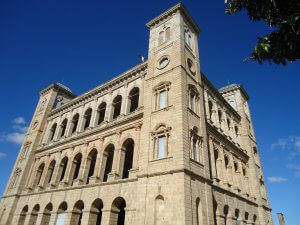 palace, he hid in the rafters, listening to the conversations they had with his wives. If he decided they were not welcome, he would drop a stone on the head of one of his wives and they would dismiss the guests and tell them never to return. If the wife did not feel the drop of a stone, she would invite the guests to explore the palace complex and the king would climb down and be seated in the palace when they returned. Another fascinating story was the construction of the largest palace on the complex, pictured on the right. It was originally built from wood, but during the rule of one of the last queens, stone was used to build around it to symbolize the country’s conversion to Christianity. Because concrete was not available during this time, the stones were held together by a mixture of egg whites crushed sea shells, and other crushed stones. Luckily, eggs were plentiful, because only recently has the Malagasy culture accepted eggs as part of their diet.
palace, he hid in the rafters, listening to the conversations they had with his wives. If he decided they were not welcome, he would drop a stone on the head of one of his wives and they would dismiss the guests and tell them never to return. If the wife did not feel the drop of a stone, she would invite the guests to explore the palace complex and the king would climb down and be seated in the palace when they returned. Another fascinating story was the construction of the largest palace on the complex, pictured on the right. It was originally built from wood, but during the rule of one of the last queens, stone was used to build around it to symbolize the country’s conversion to Christianity. Because concrete was not available during this time, the stones were held together by a mixture of egg whites crushed sea shells, and other crushed stones. Luckily, eggs were plentiful, because only recently has the Malagasy culture accepted eggs as part of their diet.
The following morning, we were awake at 5am to eat breakfast and prepare for the 12-hour journey to Kianjavato, the field station where we will be spending the next 10 weeks. We pile into a large van, and quickly leave the city behind. About an hour and a half into the 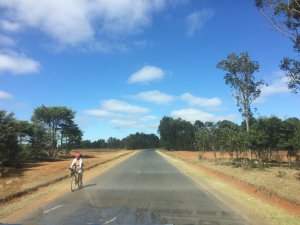 drive, American music like Shakira, Nicki Minaj, and DJ Khalid fade into static, prompting the driver to insert a Malagasy tape that plays on a loop for the rest of the day. Mountainous roads with constant switch backs induce motion sickness in most of us, at least once during the drive. But there is constantly activity on the roads or hillsides, and my neck quickly becomes sore from looking from right to left, trying to absorb as much as I can. Near villages, the streets were overtaken by carts filled with hay or bricks pulled by zebu, bicyclists, woman balancing baskets on their heads, and men or boys pushing small wooden carts filled with supplies uphill or riding them downhill like wooden go carts. Vehicles weaved past, honking to alert travelers of their upcoming presence. The villages built along the road turn from brick, to clay, to wood as we distanced ourselves from the capitol. But, reds and browns were the predominate hues of the surrounding mountains until the last few hours of the journey, when the landscape finally turned green. We passed through Ranomafana National Park and numerous tiny villages before finally arriving in Kianjavato, where we were greeted with the current volunteers and a meal consisting, of course, of rice and vegetables.
drive, American music like Shakira, Nicki Minaj, and DJ Khalid fade into static, prompting the driver to insert a Malagasy tape that plays on a loop for the rest of the day. Mountainous roads with constant switch backs induce motion sickness in most of us, at least once during the drive. But there is constantly activity on the roads or hillsides, and my neck quickly becomes sore from looking from right to left, trying to absorb as much as I can. Near villages, the streets were overtaken by carts filled with hay or bricks pulled by zebu, bicyclists, woman balancing baskets on their heads, and men or boys pushing small wooden carts filled with supplies uphill or riding them downhill like wooden go carts. Vehicles weaved past, honking to alert travelers of their upcoming presence. The villages built along the road turn from brick, to clay, to wood as we distanced ourselves from the capitol. But, reds and browns were the predominate hues of the surrounding mountains until the last few hours of the journey, when the landscape finally turned green. We passed through Ranomafana National Park and numerous tiny villages before finally arriving in Kianjavato, where we were greeted with the current volunteers and a meal consisting, of course, of rice and vegetables.